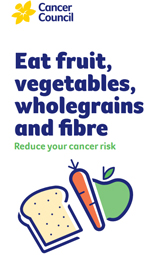- Home
- Cancer Prevention
- Diet and exercise
- Food and nutrition
- Dietary fibre
Dietary fibre and cancer risk
Dietary fibre can help to ensure a healthier digestive system and reduce the risk of bowel cancer. Eating a diet high in fibre and wholegrain foods can also lower your risk of developing type 2 diabetes and heart disease, and can help you maintain a healthy weight. Wholegrains, vegetables, fruit and legumes should form a major part of your daily diet.
What foods are high in dietary fibre?
Wholegrain and wholemeal foods are high in dietary fibre. Other foods high in fibre include fruit and vegetables, seeds, nuts and legumes such as peas, beans and lentils.
What are wholegrain and wholemeal foods?
Wholegrains include wheat, rice, corn, oats, rye, barley and millet. Wholegrains contain the three layers of the grain, the outer grain is nutrient rich and contains fibre, vitamins, minerals and phytochemicals.
Wholemeal foods are made from wholegrains which have been crushed to a finer texture. Nutritionally, wholegrain and wholemeal foods are very similar. Examples of wholegrain foods are:
- wholemeal or multi-grain bread, muffins and crumpets
- wholegrain or whole-wheat breakfast cereals or muesli
- wholemeal or mixed grain crisp bread
- brown rice, brown rice cakes
- wholemeal pasta
- corn, oats, quinoa, unpearled barley, millet or amaranth
- cracked wheat (bulgur)
- foods and flours made from rye, oats, barley or wheat.
Wholegrain foods contain more fibre, vitamins, minerals and antioxidants than foods made with refined grains such as white bread, biscuits, cakes and pastries. Refined grains have had most of the fibre removed and many of the vitamins, minerals and antioxidants are lost during processing.
How much fibre do you need to eat?
Dietary fibre is an important part of a nutritious, well balanced diet. It is recommended that Australian women eat 25g of dietary fibre per day and men 30g per day.
In order to reach this, Cancer Council recommends:
- 4-6 serves of grain foods each day with at least two-thirds being wholegrain or wholemeal varieties.
- At least five serves of vegetables (including legumes) and two serves of fruit per day. Include different types of vegetables and fruits.
It is recommended that whole foods be consumed over a dietary fibre supplement, as the benefits of fibre in food may be from the combination of nutrients present working together.
What is a serve?
One serve of wholemeal or wholegrain foods equals:
- 1 slice of wholegrain bread
- 1/2 a medium wholemeal bread roll
- 1/2 a cup of cooked brown rice, pasta or noodles
- 1/2 a cup of cooked porridge
- 2/3 of a cup of wholegrain breakfast cereal
- 1/4 cup of untoasted muesli
One serve of vegetables or legumes equals:
- ½ cup cooked vegetables
- 1 cup of salad or raw vegetables
- ½ medium potato
- ½ cup legumes e.g. soy beans, lentils, chickpeas, kidney beans
One serve of fruit equals:
- 1 medium sized piece of fruit e.g. apple, pear, orange, banana
- 2 small pieces of fruit e.g. apricots, plums, kiwifruit
- 1 cup fruit salad or canned fruit pieces
- 1 ½ tablespoons of sultanas or other dried fruit (occasionally)
- ½ cup (125mL) of unsweetened juice (occasionally)
One serve of nuts, seeds or nut and seed paste is 30g
How to get more fibre into your diet
Breakfast
- Enjoy wholegrain, wholemeal or mixed grain toast instead of white.
- Eat wholemeal English muffins or crumpets instead of white.
- Choose whole-wheat breakfast cereal or porridge with low fat milk.
- Try mushrooms, tomato, avocado or baked beans (reduced salt) on wholegrain or wholemeal toast.
- Chop up seasonal fruit and serve with reduced fat yoghurt and muesli.
Lunch
- Make sandwiches on wholemeal or mixed grain breads and add some veg.
- Try wholegrain or wholemeal crisp breads with toppings such as hummus, salsa or carrot and ricotta dip.
- Whip up a brown rice salad, wholemeal pasta salad or tabouli (made with cracked wheat).
- Make a vegie soup and add some lentils.
Dinner
- Try brown rice or quinoa with casseroles or curries.
- Use wholemeal or mixed grain dinner rolls.
- Try wholemeal pasta and wholemeal lasagne sheets.
- Include sweet corn – it counts as both a vegetable and cereal food.
- Use wholemeal flour to thicken sauces, gravies and stews.
- Add barley to stews or soups or use it instead of rice in risotto.
- Try oat topping for fruit crumbles.
- Fill half your dinner plate with vegies.
Snacks
- Snack on some popcorn.
- Munch on homemade muesli bars.
- Choose wholemeal crispbread, crackers or biscuits.
- Try muesli sprinkled over low fat yoghurt.
- Grab a small handful of unsalted almonds or walnuts.
- Munch on some vegie sticks and dip.
- Grab a banana or apple for a quick on-the-go snack.
For more recipes and ideas visit healthymadetasty.com.au
Key resource

Eat fruit, vegetables, wholegrains and fibre
Learn how to reduce your cancer risk by eating fruit, vegetables, wholegrains and fibre.
Download PDF298kB